Microstructural Differences in Response of Thermoresistant (Ceramic) and Standard (Granite) Concretes on Heating. Studies Using SEM and Nonstandard Approaches to Microtomography and Mercury Intrusion Porosimetry Data
Abstract
1. Introduction
2. Materials and Methods
2.1. Materials and Samples Preparation
2.2. Density and Porosity Estimation
2.3. SEM Analysis
2.4. X-ray Microtomography Studies
2.5. Mercury Intrusion Porosimetry Studies
3. Results and Discussion
4. Conclusions
Author Contributions
Funding
Conflicts of Interest
References
- Ulewicz, M.; Halbiniak, J. Application of waste from utilitarian ceramics for production of cement mortar and concrete. Physicochem. Probl. Miner. 2016, 52, 1002–1010. [Google Scholar]
- Guerra, I.; Vivar, I.; Liamas, B.; Juan, A.; Moran, J. Eco-efficient concretes: The effects of using recycled ceramic material from sanitary installations on the mechanical properties of concrete. Waste Manag. 2009, 29, 643–646. [Google Scholar] [CrossRef] [PubMed]
- Jackiewicz-Rek, W.; Zalegowski, K.; Gabacz, A.; Bissonnettee, B. Properties of cement mortars modified with ceramic waste fillers. Procedia Eng. 2015, 108, 681–687. [Google Scholar] [CrossRef]
- Medina, C.; Sanchez de Rojas, M.I.; Frias, M. Reuse of sanitary ceramic wastes as coarse aggregate in eco-efficient concretes. Cem. Concr. Compos. 2012, 34, 48–54. [Google Scholar] [CrossRef]
- Markiv, T.; Sobol, K.; Franus, M.; Franus, W. Mechanical and durability properties of concretes incorporating natural zeolite. Arch. Civ. Mech. Eng. 2016, 16, 554–562. [Google Scholar] [CrossRef]
- Dobiszewska, M. Waste materials used in making mortar and concrete. J. Mater. Educ. 2017, 39, 133–156. [Google Scholar]
- Medina, C.; Frías, M.; Sanchez de Rojas, M.I. Microstructure and properties of recycled concretes using sanitary ware industry waste as coarse aggregate. Constr. Build. Mater. 2012, 31, 112–118. [Google Scholar] [CrossRef]
- Medina, C.; Frias, M.; Sanchez de Rojas, M.I.; Thomas, C.; Polanco, J.A. Gas permeability in concrete containing recycled ceramic ware aggregate. Constr. Build. Mater. 2012, 37, 597–605. [Google Scholar] [CrossRef]
- Canbaz, M. The effect on High Temperature on Concrete with Waste Ceramic Aggregate. IJST-T Civ. 2016, 40, 41–48. [Google Scholar] [CrossRef]
- Halicka, A.; Zegardło, B.; Ogrodnik, P. Using ceramic sanitary ware waste as concrete aggregate. Constr. Build. Mater. 2013, 48, 295–305. [Google Scholar] [CrossRef]
- Zegardlo, B.; Szelag, M.; Ogrodnik, P. Ultra-high strength concrete made with recycled aggregate from sanitary wastes—The method of production and the interfacial transition zone. Constr. Build. Mater. 2016, 122, 736–742. [Google Scholar] [CrossRef]
- Poon, C.-S.; Azhar, S.; Anson, M.; Wong, Y.-L. Comparison of the strength and durability performance of normal- and high-strength pozzolanic concretes at elevated temperatures. Cem. Concr. Res. 2001, 31, 1291–1300. [Google Scholar] [CrossRef]
- Handoo, S.K.; Agarwal, S.; Agarwal, S.K. Physicochemical, mineralogical, and morphological characteristics of concrete exposed to elevated temperatures. Cem. Concr. Res. 2002, 32, 1009–1018. [Google Scholar] [CrossRef]
- Zhang, L.W.; Kai, M.F.; Liew, K.M. Evaluation of microstructure and mechanical performance of CNT reinforced cementitious composites at elevated temperatures. Compos. Part A 2017, 95, 286–293. [Google Scholar] [CrossRef]
- Kamseu, E.; Catania, V.; Djangang, C.; Sglavo, V.M.; Leonelli, C. Correlation between microstructural evolution and mechanical properties of α-quartz and alumina reinforced K-geopolymers during high temperature treatments. Adv. Appl. Ceram. 2012, 111, 3–14. [Google Scholar] [CrossRef]
- Ju, Y.; Liu, J.; Liu, H.; Tian, K.; Ge, Z. On the thermal spalling mechanism of reactive powder concrete exposed to high temperature: Numerical and experimental studies. Int. J. Heat Mass Transf. 2016, 98, 493–507. [Google Scholar] [CrossRef]
- Aleksandrov Fabijanic, T.; Alar, Z.; Coric, D. Influence of consolidation process and sintering temperature on microstructure and mechanical properties of near nano- and nano-structured WC-Co cemented carbides. Int. J. Refract. Met. Hard Mater. 2016, 54, 82–89. [Google Scholar] [CrossRef]
- Xiao, J.; Li, Z.; Xie, Q.; Shen, L. Effect of strain rate on compressive behaviour of high-strength concrete after exposure to elevated temperatures. Fire Saf. J. 2016, 83, 25–37. [Google Scholar] [CrossRef]
- Heikal, M.; Al-Duaij, O.K.; Ibrahim, N.S. Microstructure of composite cements containing blast-furnace slag and silica nano-particles subjected to elevated thermally treatment temperature. Constr. Build. Mater. 2015, 93, 1067–1077. [Google Scholar] [CrossRef]
- Beycioglu, A.; Gultekin, A.; Aruntas, H.Y.; Gencel, O.; Dobiszewska, M.; Brostow, W. Mechanical properties of blended cements at elevated temperatures predicted using a fuzzy logic model. Comput. Concr. 2017, 20, 247–255. [Google Scholar] [CrossRef]
- Pastorino, D.; Canal, C.; Ginebra, M.P. Multiple characterization study on porosity and pore structure of calcium phosphate cements. Acta Biomater. 2015, 28, 205–214. [Google Scholar] [CrossRef] [PubMed]
- Alderete, N.; Villagran, Y.; Mignon, A.; Snoeck, D.; De Belie, N. Pore structure description of mortars containing ground granulated blast-furnace slag by mercury intrusion porosimetry and dynamic vapour sorption. Constr. Build. Mater. 2017, 145, 157–165. [Google Scholar] [CrossRef]
- Wyrzykowski, M.; Kiesewetter, R.; Kaufmann, J.; Baumann, R.; Lura, P. Pore structure of mortars with cellulose ether additions—Mercury intrusion porosimetry study. Cem. Concr. Compos. 2014, 53, 25–34. [Google Scholar] [CrossRef]
- Panesar, D.K.; Francis, J. Influence of limestone and slag on the pore structure of cement paste based on mercury intrusion porosimetry and water vapour sorption measurements. Constr. Build. Mater. 2014, 52, 52–58. [Google Scholar] [CrossRef]
- Da Silva, I.B. X-ray Computed Microtomography technique applied for cementitious materials: A review. Micron 2018, 107, 1–8. [Google Scholar] [CrossRef] [PubMed]
- Leite, M.B.; Monteiro, P.J.M. Microstructural analysis of recycled concrete using X-ray microtomography. Cem. Concr. Res. 2016, 81, 38–48. [Google Scholar] [CrossRef]
- Huang, J.; Krabbenhoft, K.; Lyamin, A.V. Statistical homogenization of elastic properties of cement paste based on X-ray microtomography images. Int. J. Solids Struct. 2013, 50, 699–709. [Google Scholar] [CrossRef]
- Sahu, S.; Badger, S.; Thaulow, N.; Lee, R.J. Determination of water–cement ratio of hardened concrete by scanning electron microscopy. Cem. Concr. Compos. 2004, 26, 987–992. [Google Scholar] [CrossRef]
- Richards, O.; Rickard, I.; Orr, J.; Bisby, L. Response of concrete cast in permeable moulds to severe heating. Constr. Build. Mater. 2018, 160, 526–538. [Google Scholar] [CrossRef]
- Gregerova, M.; Vsiansky, D. Identification of concrete deteriorating minerals by polarizing and scanning electron microscopy. Mater. Charact. 2009, 60, 680–685. [Google Scholar] [CrossRef]
- Safiuddin, M.; Yakhlaf, M.; Soudki, K.A. Key mechanical properties and microstructure of carbon fibre reinforced self-consolidating concrete. Constr. Build. Mater. 2018, 164, 477–488. [Google Scholar] [CrossRef]
- Diamond, S. Mercury porosimetry: An inappropriate method for the measurement of pore size distributions in cement-based materials. Cem. Concr. Res. 2000, 30, 1517–1525. [Google Scholar] [CrossRef]
- Zhou, J.; Ye, G.; van Breugel, K. Characterization of pore structure in cement-based materials using pressurization–depressurization cycling mercury intrusion porosimetry (PDC-MIP). Cem. Concr. Res. 2010, 40, 1120–1128. [Google Scholar] [CrossRef]
- Campos, R.; Barrios, I.; Lillo, J. Experimental CO2 injection: Study of physical changes in sandstone porous media using Hg porosimetry and 3D pore network models. Energy Rep. 2015, 1, 71–79. [Google Scholar] [CrossRef]
- Maji, A.K. Review of Noninvasive Techniques for Detecting Microfracture. Adv. Cem. Mater. 1995, 2, 201–209. [Google Scholar] [CrossRef]
- Groena, J.C.; Peffer, L.A.A.; Perez-Ramirez, J. Incorporation of appropriate contact angles in textural characterization by mercury porosimetry. Stud. Surf. Sci. Catal. 2002, 144, 91–98. [Google Scholar] [CrossRef]
- Thompson, A.H.; Katz, A.J.; Krohn, C.E. The microgeometry and transport properties of sedimentary rocks. Adv. Phys. 1987, 36, 625–694. [Google Scholar] [CrossRef]
- Jozefaciuk, G. Effect of the size of aggregates on pore characteristics of minerals measured by mercury intrusion and water-vapor desorption techniques. Clays Clay Miner. 2009, 57, 586–601. [Google Scholar] [CrossRef]
- Sridharan, A.; Venkatappa Rao, G. Pore size distribution of soils from mercury intrusion porosimetry data. Soil Sci. Soc. Am. J. 1972, 36, 980–981. [Google Scholar] [CrossRef]
- Pachepsky, Y.A.; Polubesova, T.A.; Hajnos, M.; Sokolowska, Z.; Jozefaciuk, G. Fractal parameters of pore surface area as influences by simulated soil degradation. Soil Sci. Soc. Am. J. 1995, 59, 68–75. [Google Scholar] [CrossRef]
- Yokoya, N.; Yamamato, K.; Funakuro, N. Fractal based analysis and interpolation of 3D natural surface shapes and their application to terrain modelling. Comput. Vis. Graph. Image Process. 1989, 46, 284–302. [Google Scholar] [CrossRef]
- Dullien, F.A.L.; Dhawan, G.K. Bivariate pore size distributions of some sandstones. J. Colloid Interface Sci. 1975, 52, 129–135. [Google Scholar] [CrossRef]
- Jozefaciuk, G.; Czachor, H.; Lamorski, K.; Hajnos, M.; Swieboda, R.; Franus, W. Effect of humic acids, sesquioxides and silica on the pore system of silt aggregates measured by water vapour desorption, mercury intrusion and microtomography. Eur. J. Soil Sci. 2015, 66, 992–1001. [Google Scholar] [CrossRef]
- Franus, W.; Panek, R.; Wdowin, M. SEM Investigation of Microstructures in Hydration Products of Portland Cement. In Springer Proceedings in Physics; Springer: Cham, Switzerland, 2015; Volume 164, pp. 105–112. [Google Scholar]
- Wang, X.S.; Wu, B.S.; Wang, Q.Y. Online SEM investigation of microcrack characteristics of concretes at various temperatures. Cem. Concr. Res. 2005, 35, 1385–1390. [Google Scholar] [CrossRef]
- Vydra, V.; Vodak, F.; Kapickova, O.; Hoskova, S. Effect of temperature on porosity of concrete for nuclear-safety structures. Cem. Concr. Res. 2001, 31, 1023–1026. [Google Scholar] [CrossRef]
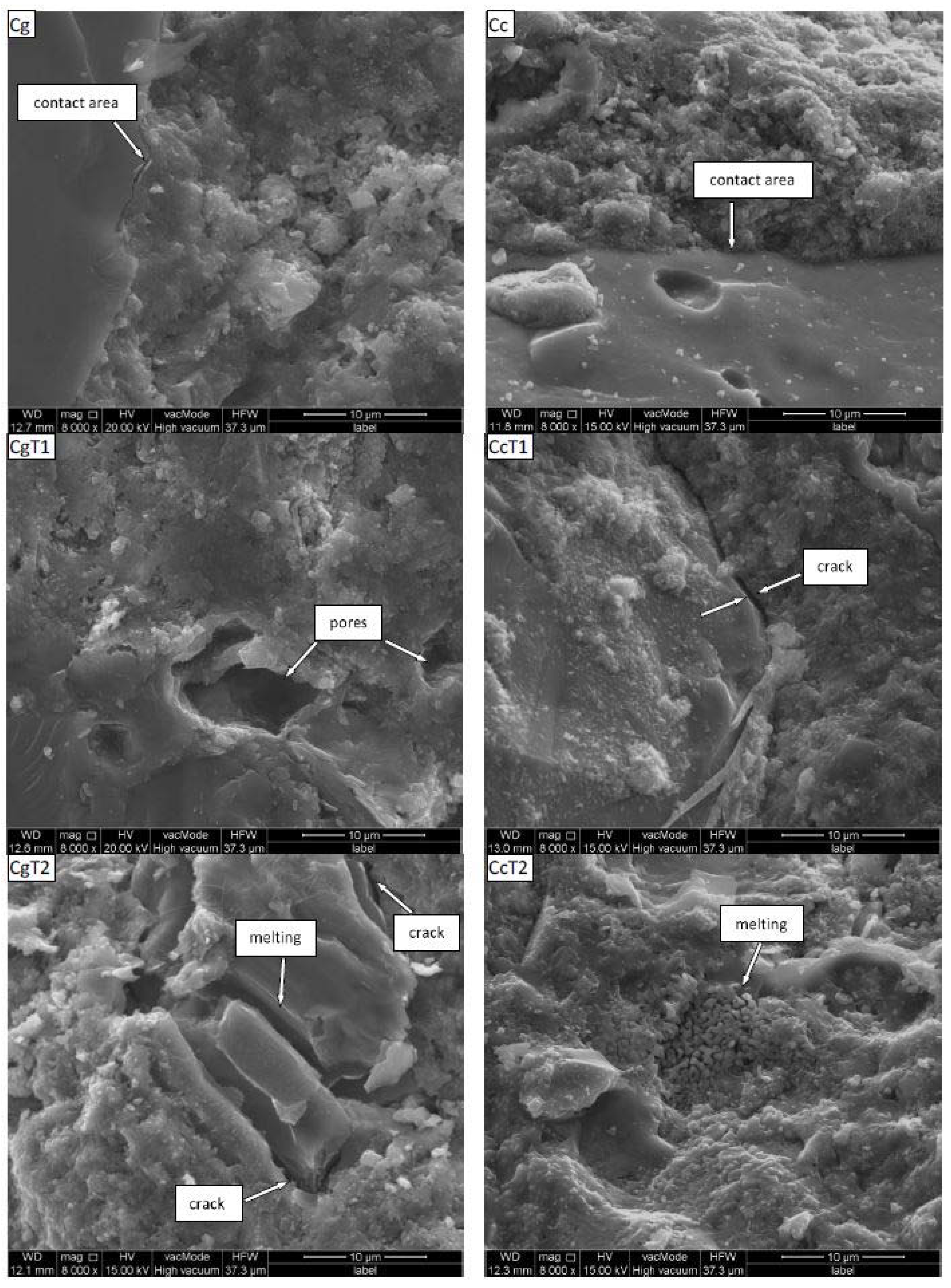
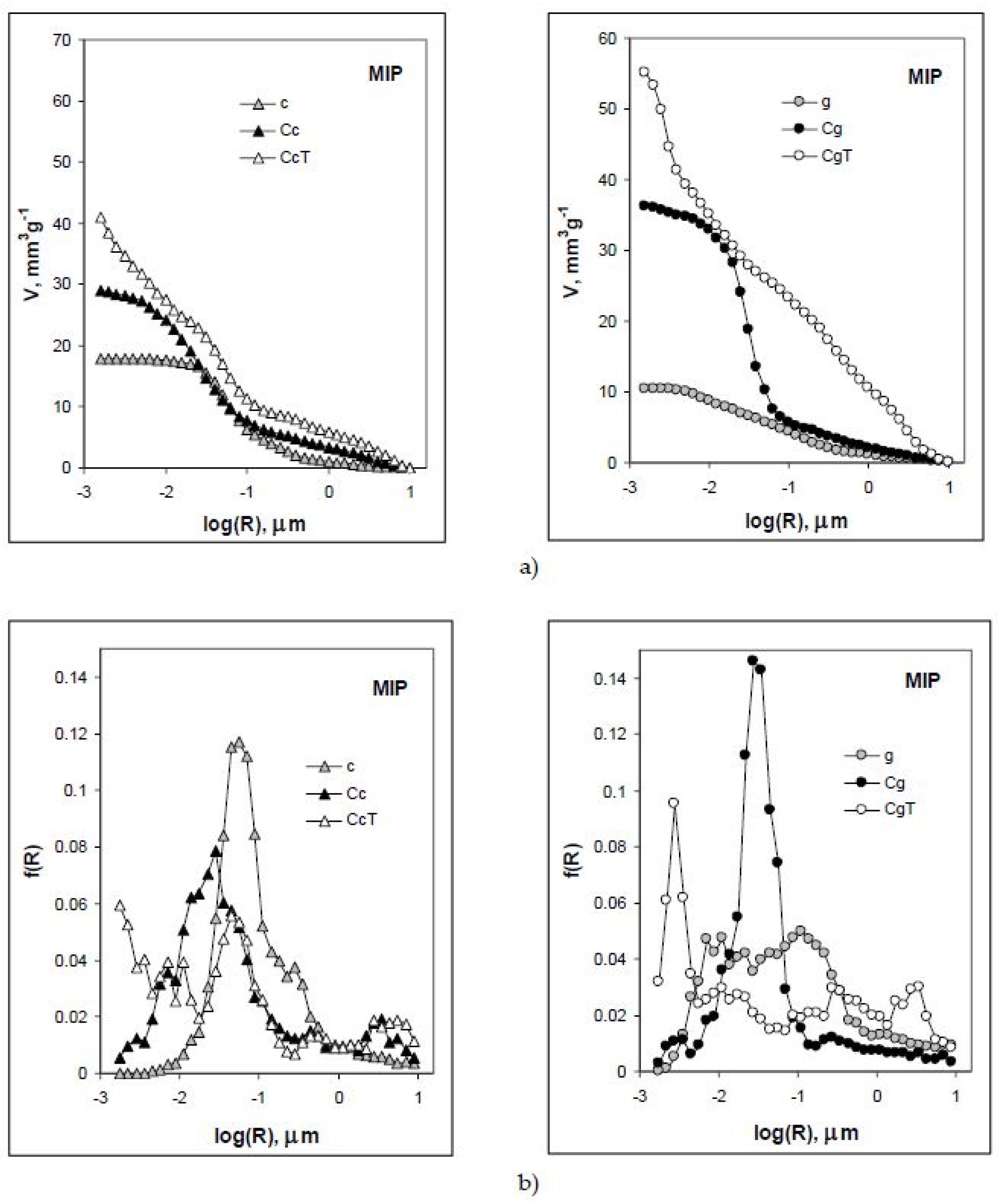
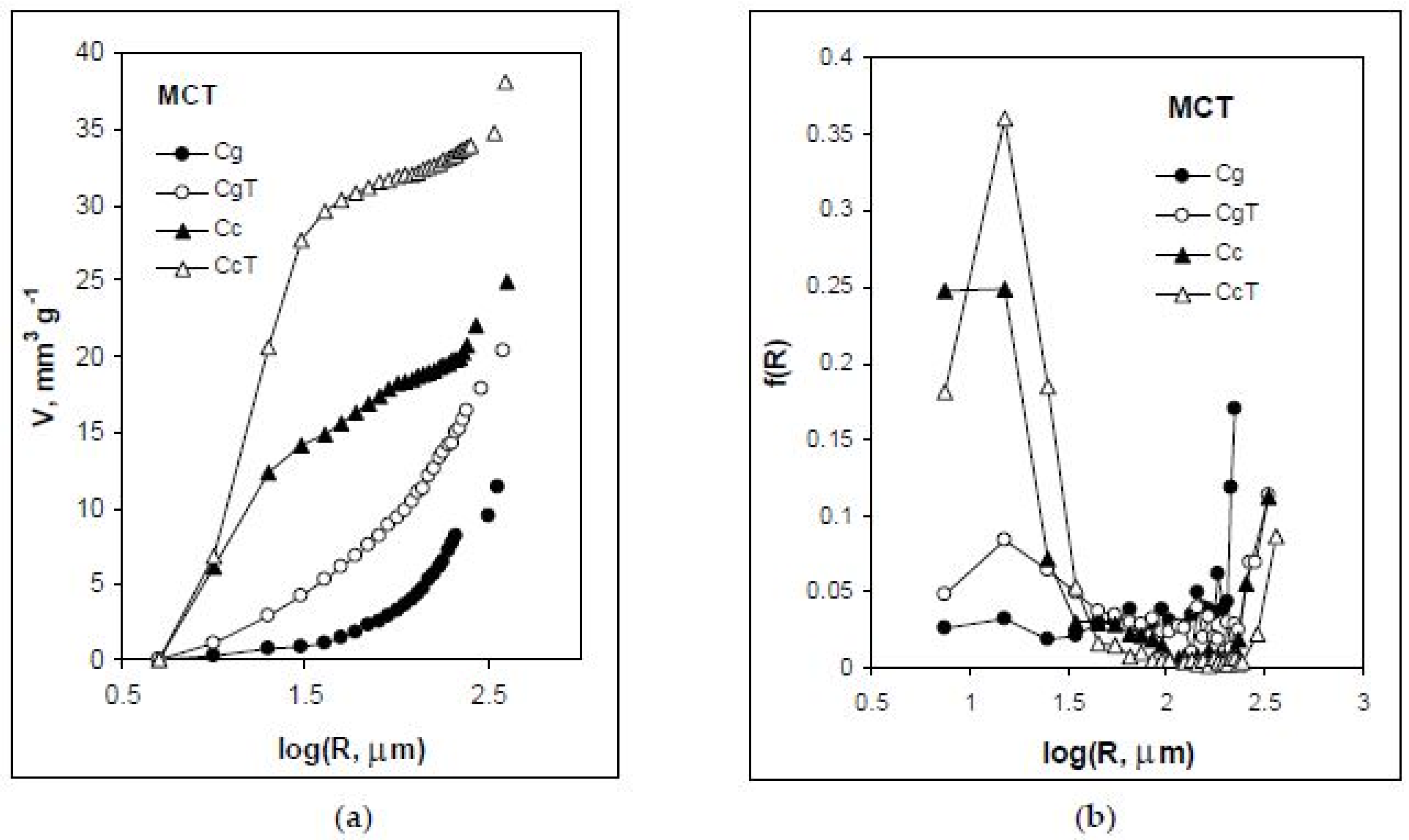
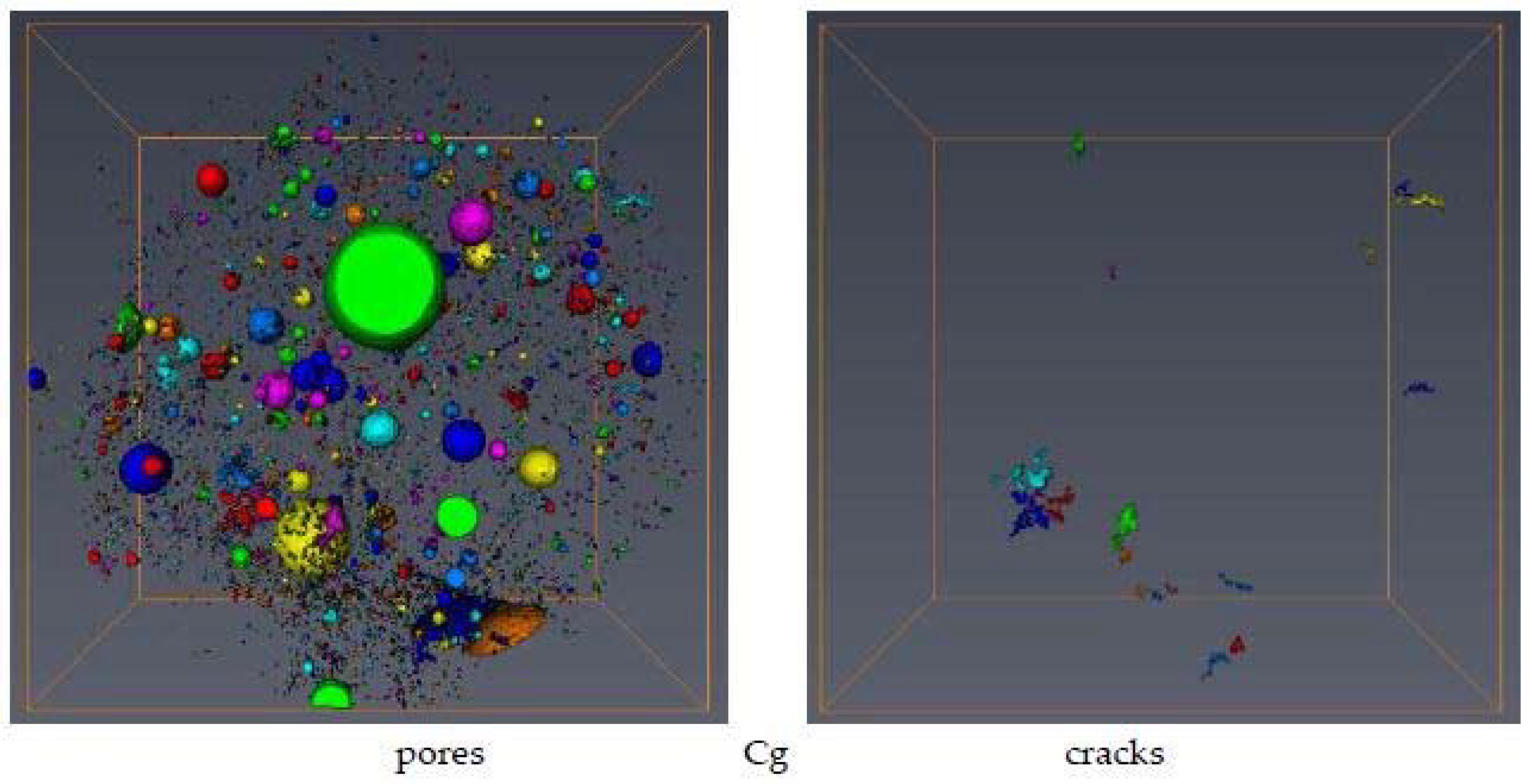

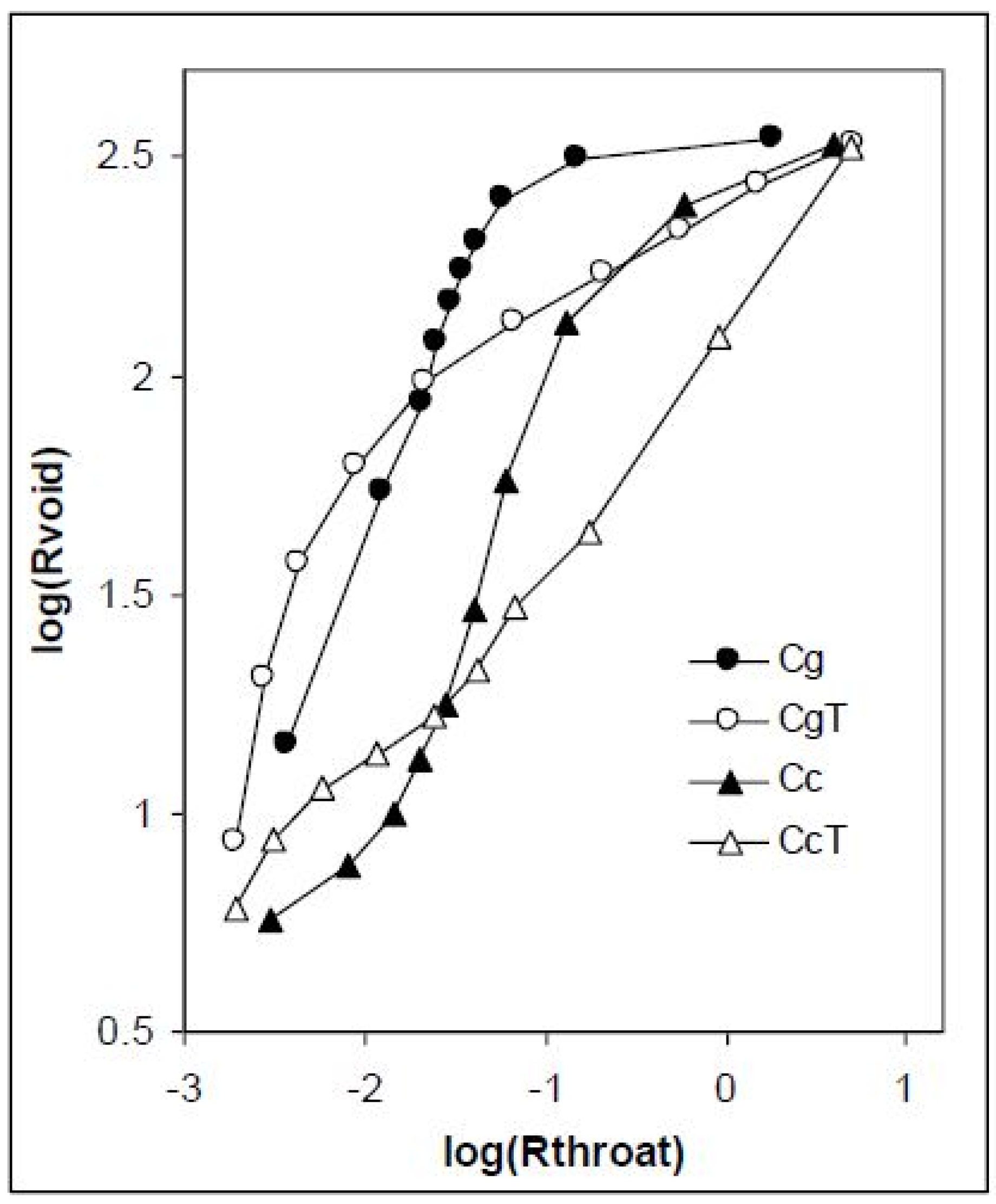
| Parameter | Unit | g | Cg | CgT | c | Cc | CcT |
|---|---|---|---|---|---|---|---|
| Particle Density (mass and volume) | g cm−3 | 2.63 | 2.38 | 2.28 | 2.40 | 2.34 | 2.24 |
| Particle Density (MIP) | g cm−3 | 2.56 | 2.35 | 2.22 | 2.35 | 2.31 | 2.24 |
| Solid-Phase Density (He pycnometry) | g cm−3 | 2.74 | 2.62 | 2.63 | 2.55 | 2.51 | 2.50 |
| Solid-Phase Density (MIP) | g cm−3 | 2.71 | 2.60 | 2.58 | 2.53 | 2.49 | 2.50 |
| Pore Volume (MIP) | mm3 g−1 | 15.0 | 39.7 | 61.6 | 21.2 | 31.9 | 46.4 |
| Pore Volume (MCT) | mm3 g−1 | n.d. | 11.4 | 20.4 | n.d. | 24.9 | 38.0 |
| Pore volume (Part. Dens./He pyc.) | mm3 g−1 | 15.3 | 38.5 | 58.4 | 24.5 | 28.9 | 46.4 |
| Internal Pores Volume (MIP) | mm3 g−1 | 10.4 | 36.1 | 55.0 | 17.8 | 28.9 | 41.0 |
| Porosity (MIP) | % v/v | 5.47 | 9.33 | 13.69 | 7.12 | 7.37 | 10.39 |
| Porosity (MCT) | % v/v | n.d. | 2.68 | 4.53 | n.d. | 5.75 | 8.51 |
| Porosity (Part. Dens./He pyc.) | % v/v | 4.01 | 9.16 | 13.31 | 5.88 | 6.77 | 10.40 |
| Average Pore Radius (MIP) | μm | 0.50 | 0.08 | 0.11 | 0.25 | 0.09 | 0.08 |
| Average Radius of Internal Pores (MIP) | μm | 0.073 | 0.044 | 0.057 | 0.096 | 0.056 | 0.047 |
| Average Pore Radius (MCT) | μm | n.d. | 118.7 | 93.7 | n.d. | 34.2 | 26.5 |
| Total Pore Area (MIP) | m2 g−1 | 1.39 | 3.49 | 14.04 | 0.91 | 3.25 | 10.33 |
| Fractal dimension (MCT) | - | n.d. | 1.85 | 2.17 | n.d. | 2.45 | 2.61 |
| Fractal dimension (MIP) | - | 3.35 | 3.28 | 3.20 | 3.55 | 3.26 | 3.10 |
| Volume of cracks (MCT) | mm3 g−1 | n.d. | 0.12 | 7.38 | n.d. | 1.27 | 2.99 |
© 2018 by the authors. Licensee MDPI, Basel, Switzerland. This article is an open access article distributed under the terms and conditions of the Creative Commons Attribution (CC BY) license (http://creativecommons.org/licenses/by/4.0/).
Share and Cite
Franus, W.; Halicka, A.; Lamorski, K.; Jozefaciuk, G. Microstructural Differences in Response of Thermoresistant (Ceramic) and Standard (Granite) Concretes on Heating. Studies Using SEM and Nonstandard Approaches to Microtomography and Mercury Intrusion Porosimetry Data. Materials 2018, 11, 1126. https://doi.org/10.3390/ma11071126
Franus W, Halicka A, Lamorski K, Jozefaciuk G. Microstructural Differences in Response of Thermoresistant (Ceramic) and Standard (Granite) Concretes on Heating. Studies Using SEM and Nonstandard Approaches to Microtomography and Mercury Intrusion Porosimetry Data. Materials. 2018; 11(7):1126. https://doi.org/10.3390/ma11071126
Chicago/Turabian StyleFranus, Wojciech, Anna Halicka, Krzysztof Lamorski, and Grzegorz Jozefaciuk. 2018. "Microstructural Differences in Response of Thermoresistant (Ceramic) and Standard (Granite) Concretes on Heating. Studies Using SEM and Nonstandard Approaches to Microtomography and Mercury Intrusion Porosimetry Data" Materials 11, no. 7: 1126. https://doi.org/10.3390/ma11071126
APA StyleFranus, W., Halicka, A., Lamorski, K., & Jozefaciuk, G. (2018). Microstructural Differences in Response of Thermoresistant (Ceramic) and Standard (Granite) Concretes on Heating. Studies Using SEM and Nonstandard Approaches to Microtomography and Mercury Intrusion Porosimetry Data. Materials, 11(7), 1126. https://doi.org/10.3390/ma11071126






